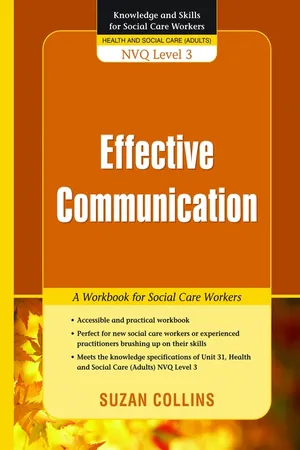
- 112 pages
- English
- ePUB (mobile friendly)
- Available on iOS & Android
About This Book
Social care workers in residential or domiciliary settings need to be able to communicate effectively in order to carry out their work.
Supporting people with a variety of difficulties including hearing loss, impaired speech, visual impairment, dementia and physical and learning disabilities requires a range of communication skills, such as listening, sign language, writing notes, and using body language, touch and stimulation. This workbook will provide workers with the ability to enable adults with limited or no verbal communication skills to make decisions, and to express their views in their preferred method of communication.
Effective Communication includes practical guidance on using communication tools, such as computers, staff photo rota boards and pictorial menu boards, and use of photographs as visual reminders. The workbook meets the requirements of care standards and also refers to the importance of recording and reporting, and dealing with sensitive and complex issues, such as breaking the news of a family bereavement, or communicating with a person who has been abused.
Designed to meet the requirements of Health and Social Care (Adults) NVQ Level 3, Unit 31, this workbook is also a valuable source of guidance for any social care worker wanting to improve communication with the people they support.
Frequently asked questions
Information



Mr A’s roles | My roles |
.............................. | .............................. |
.............................. | .............................. |
.............................. | .............................. |
.............................. | .............................. |
Table of contents
- Cover
- Other Books in the Series
- Title Page
- Copyright
- Acknowledgement
- Dedication
- Contents
- Introduction
- Why We Need to be Able to Communicate
- Communication within your Team, Families and Outside Agencies
- Capacity to Make a Decision
- Communicating with an Individual
- Communication Profile or Communication Passport
- Problems in Communication
- The Different Ways We Communicate
- Providing Opportunities to Communicate
- Communication Cycle
- Listening Skills
- Factors Affecting Communication
- Visual Reminders
- Stimulation
- Feelings, Emotions and Relationships
- Objects of Reference
- Using Photographs
- Alternative Ways of Communicating
- Making Choices
- Personal Space
- Body Language
- Supporting Various Kinds of Service Users
- Sensitive and Complex Issues
- Human Growth and Development
- Recording and Reporting
- Confidentiality
- Data Protection Act 1998
- Access of Health Records Act 1990
- Self-Assessment Tool
- Certificate
- Knowledge Specification Chart
- Legislation and Useful Websites
- References